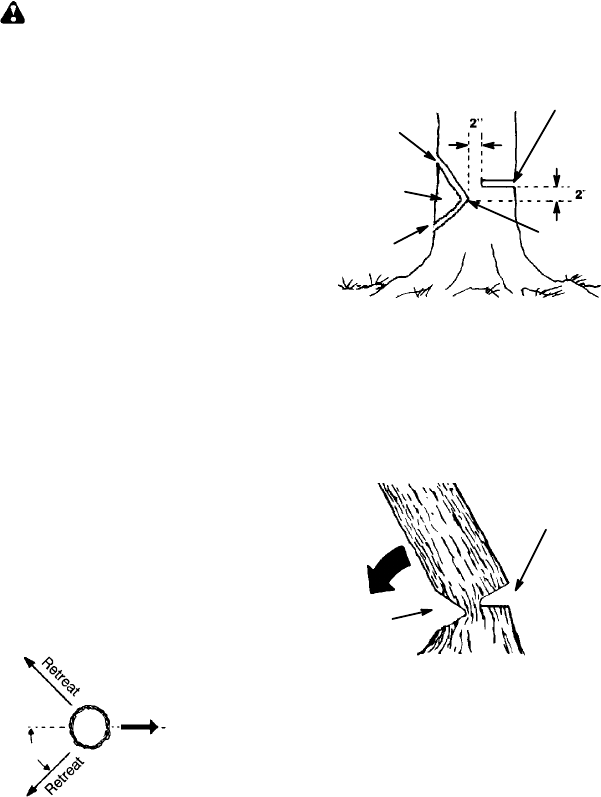
11
S Allow the chain to cut for you. Exert
only light downward pressure. If you
force the cut, damage to the bar,
chain, or engine can result.
S Releasethethrottletriggeras soonas
the cut is completed, allowing the en-
gine to idle. If you run the saw at full
throttle without a cutting load, unnec-
essary wear can occur to t he chain,
bar, and engine.
S To avoid losing control when cut is
complete, donot put pressure onsaw
at end of cut.
S Stop the engine before setting the saw
down after cutting.
TREE FELLING TECHNIQUES
WARNING: Check for broken or
dead branches which can fall while cutting
causingserious injury. Donotcutnearbuild-
ingsor electricalwires ifyoudonotknowthe
directionoftreefall,norcutatnightsinceyou
will not be ale to see well, nor during bad
weathersuchasrain,snow,or strongwinds,
etc. Ifthe treemakes contactwith anyutility
line, the u tility company should be not ified
immediately .
S Carefullyplanyoursawingoperationinad-
vance.
S Cleartheworkarea. Youneedacleararea
allaroundthetreesoyoucanhavesecure
footing.
S The chain saw operator should keep on
the uphill side of the terrain as the tree i s
likelytorollorslidedownhillafteritisfelled.
S Stu dy t he natural co nditio ns th at can ca use
the tree t o fall in a particular direction.
Natural conditions that can cause a tree to
fall in aparticular direction include:
S The wind direction and speed.
S The lean of the tree. The lean of a tree
might not be apparent due to uneven or
slopingterrain. Useaplumborlevel tode-
termine the direction of tree lean.
S Weight and branches o n one side.
S Surrounding trees and obstacles.
Look for decay and rot. If thetrunk isrotted,
it can snap and fall toward the operator.
Check for broken or dead br anches which
can f all on you while cutting.
Make sure there is enough room for the tree to
fall. Maintain a distance o f
2-1/2 tree lengths
from the nearest person o r other objects. En-
gine noise can drown out a warning call.
Remove dirt, stones, loose bark, nails, sta-
ples,andwirefromthetreewherecuts areto
be made.
Planaclearretreat pathto therear anddiag-
onal to the line of fall.
Direction of Fall
45_
Plan a clear retreat path
FELLING LARGE TREES
(6 inches in diam eter or larger)
The notch method is used to felllarge trees.
Anotchis cutonthesideofthetreeinthede-
sired direction of fall. After a felling cut is
made on the opposite side of tree, the tree
will tend to fall into the notch.
NOTE: If thetree has large buttress roots,
removethembeforemakingthenotch. Ifus-
ing saw to remove buttress roots, keep saw
chainfromcontactinggroundtopreventdull-
ing of the chain.
NOTCH CUT AN D FELLING THE
TREE
S Make notch cut by cutting the top of the
notch first. Cut through
1/3 ofthe diameter
ofthetree.Nextcompletethenotchbycut-
ting the bottom of the notch. See illustra-
tion. Once the notch is cut remove the
notch of wood from the tree.
Notch
First cut
Second cut
Final (felling) cut here. 2 in-
ches above center of notch.
Hinge
S After removing the wood from the notch,
makethefellingcutontheoppositesideof
the notch. This is done by making a cut
abouttwo inches higherthanthe center of
the notch. This will leave enough uncut
woodbetweenthefellingcutandthenotch
to form a hinge. This hinge will help pre-
ventthetreefromfallinginthewrongdirec-
tion.
Opening
of felling
cut
Closing of
notch
Hinge holds tree on stump and helps
control fall
NOTE: Before felling cut is complete, use
wedges to open the cut if necessary to
controlthedirectionoffall. Toavoidkickback
and chain damage, use wood or plastic
wedges, but never steel or iron wedges.
S Be alert to signs that the tree is ready to
fall: cracking sounds, widening of the fell-
ing cut, or movement in the upper
branches.


















